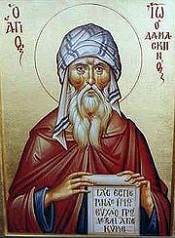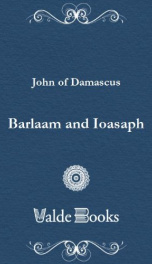John of Damascus Saint

Saint John of Damascus (Arabic: يوحنا الدمشقي Yuḥannā Al Demashqi; Greek: Ιωάννης Δαμασκήνος Iôannês Damaskênos; Latin: Iohannes Damascenus; also known as John Damascene, Χρυσορρόας/Chrysorrhoas, "streaming with gold"—i.e., "the golden speaker") (c. 676 – 4 December, 749) was an Arab Christian monk and priest. Born and raised in Damascus, he died at his monastery, Mar Saba, near Jerusalem.[1] A polymath whose fields of interest and contribution included law, theology, philosophy, and music, before being ordained, he served as a Chief Administrator to the Muslim caliph of Damascus, wrote works expounding the Christian faith, and composed hymns which are still in everyday use in Eastern Christian monasteries throughout the world. The Catholic Church regards him as a Doctor of the Church, often referred to as the Doctor of the Assumption due to his writings on the Assumption of Mary.[2] The most commonly used source for information on the life of John of Damascus is a work attributed to one John of Jerusalem, identified therein as the Patriarch of Jerusalem.[3] It is actually an excerpted translation into Greek of an earlier Arabic text. The Arabic original contains a prologue not in found in most other translations that was written by an Arabic monk named Michael who relates his decision to write a biography of John of Damascus in 1084, noting that none was available in either Greek or Arabic at the time. The main text that follows in the original Arabic version seems to have been written by another, even earlier author, sometime between the early 9th and late 10th centuries AD.[3] Written from a hagiographical point of view and prone to exaggeration, it is not the best historical source for his life, but is widely reproduced and considered to be of some value nonetheless.[4] The hagiographic novel Barlaam and Josaphat, traditionally attributed to John, is in fact a work of the 10th century.[5] John was born into a prominent Arab Christian family known as Mansour (Arabic: Mansǔr, "victory") in Damascus in the 7th century AD.[6][7] He was named Mansur b. Sarjun ("Mansur, son of Sarjun") after his grandfather who had been responsible for the taxes of the region under the Emperor Heraclius.[6] When the region came under Arab Muslim rule in the late 7th century AD, the court at Damascus remained full of Christian civil servants, John's grandfather among them.[6][8] John's father, Sarjun (Sergius) or Ibn Mansur, went on to serve the Umayyad caliphs, supervising taxes for the entire Middle East.[6] After his father's death, John also served as a high official to the caliphate court before leaving to become a monk and adopting the monastic name John at Mar Saba, where he was ordained as a priest in 735.[6][7] John was educated in Damascus in the traditional Hellenic way, an education described as secular by one source and "Classical Christian" by another.[9][10] One account identifies his tutor as a monk by the name of Cosmas, who had been captured by Arabs from his home in Sicily, and for whom John's father paid a great price. Under the instruction of Cosmas, who also taught John's orphan friend (the future St. Cosmas of Maiuma), John is said to have made great advances in music, astronomy and theology, soon rivaling Pythagoras in arithmetic and Euclid in geometry.[10] In the early 8th century AD, iconoclasm, a movement seeking to prohibit the veneration of the icons, gained some acceptance in the Byzantine court. In 726, despite the protests of St. Germanus, Patriarch of Constantinople, Emperor Leo III issued his first edict against the veneration of images and their exhibition in public places. A talented writer in the secure surroundings of the caliph's court, John of Damascus initiated a defense of holy images in three separate publications. "Apologetic Treatises against those Decrying the Holy Images", the earliest of these works gained him a reputation. Not only did he attack the emperor, but the use of a simpler literary style brought the controversy to the common people, inciting revolt among those of Christian faith. His writings later played an important role during the Second Council of Nicaea which met to settle the icon dispute. To counter his influence, Leo III is said to have had documents forged implicating John of Damascus in a plot to attack Damascus. Called to account for these writings by the caliph, John asked to leave his post and retire to Mar Saba near Jerusalem. There, he studied, wrote and preached until he was ordained a priest in 735.[7] A legendary Greek account adds that before going to Mar Saba his right hand was ordered cut off at the wrist by the caliph, and that it was miraculously restored after fervent prayer before an icon of the Virgin Mary (later named "Trojeručica").[11] John died in 749 as a revered Father of the Church, and is recognized as a saint. He is sometimes called the last of the Church Fathers by the Roman Catholic Church. In 1883 he was declared a Doctor of the Church by the Holy See. When the name of Saint John of Damascus was inserted in the General Roman Calendar in 1890, it was assigned to 27 March. This date always falls within Lent, a period during which there are no obligatory Memorials. The feast day was therefore moved in 1969 to the day of the saint's death, 4 December, the day on which his feast day is celebrated also in the Byzantine Rite calendar.[12]
do you like this author?
What readers are saying
What do you think? Write your own comment on this book!
write a commentWhat readers are saying
What do you think? Write your own comment on this author!
write a commentBook list

Barlaam and Ioasaph
Series:
Unknown
Year:
Unknown
Raiting:
4/5
This book was converted from its physical edition to the digital format by a community of volunteers. You may find it for free on the web. Purchase of the Kindle edition includes wireless delivery.
Show more
add to favoritesadd In favorites
Book list

Barlaam and Ioasaph
Series:
Unknown
Year:
Unknown
Raiting:
4/5
This book was converted from its physical edition to the digital format by a community of volunteers. You may find it for free on the web. Purchase of the Kindle edition includes wireless delivery.
Show more
add to favoritesadd In favorites
What readers are saying
What do you think? Write your own comment on this author!
write a commentif you like John of Damascus Saint try:
readers also enjoyed
What readers are saying
What do you think? Write your own comment on this author!
write a commentif you like John of Damascus Saint try:
readers also enjoyed
Do you want to exchange books? It’s EASY!
Get registered and find other users who want to give their favourite books to good hands!

